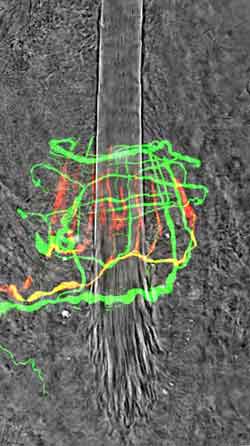The Molecular Basis of Touch Sensation – MDC Researchers Identify New Function of a Well-Known Gene

Mechanosensory endings of nerve cells in the skin detect touch stimuli. Here various nerve endings (red and green) nestle around the shaft of a hair (grey, fibrous structure), which is anchored in a hair follicle. The nerve endings are stimulated by movements of the hair. The mechanical stimulus is converted into electrical signals which are transmitted to the brain. (Photo: Hagen Wende/Copyright: MDC)<br>
They found that in mice in which they had removed the c-Maf gene in the nerve cells, touch sensation is impaired. This similarly applies to human carriers of a mutant c-Maf gene. People with such a mutation suffer already at a young age from cataracts, a clouding of the lens which typically affects the elderly (Scienceexpress, 16 Februrary 2012/10.1126/science.1214314)*.
The patients, as demonstrated by Professor Carmen Birchmeier and Dr. Hagen Wende in collaboration with Professor Gary Lewin and Dr. Stefan Lechner, have difficulty holding objects such as a sheet of paper as a consequence of this mutation. Professor Birchmeier, a developmental biologist, commented on the findings of her research group: “c-Maf is an important gene for the development of the peripheral nerve cells.” The gene controls the development of neurons that detect touch, the mechanosensory neurons. Previously, c-Maf was known as a key regulator of lens development.
Furthermore, the gene is also active in the dorsal root ganglia, an aggregate of nerve cells next to the spinal cord in which the cell bodies of mechanosensory neurons are localized. The nerve cells form long axons, which terminate in the skin in touch corpuscles or at hair shafts. These axons detect mechanical stimuli, which in turn are converted into electrical signals and transmitted to the brain. When you stroke your fingers over a surface, its structure triggers high-frequency vibrations in the finger, to which specific touch receptors, the Pacinian corpuscles, respond.
In mice with deactivated c-Maf gene only few Pacinian corpuscles are formed, and moreover these few are not intact. The mice are therefore unable to recognize high-frequency vibrations. The same is true for a Swiss family with an inherited mutant c-Maf gene. The consequence is that the affected patients develop cataracts at an early age and have an impaired sense of touch.
*The transcription factor c-Maf controls touch receptor development and function
Hagen Wende1, Stefan G. Lechner2, Cyril Cheret1, Steeve Bourane3, Maria E. Kolanczyk1, Alexandre Pattyn4, Katja Reuter1,5, Francis L. Munier6, Patrick Carroll4, Gary R. Lewin2 and Carmen Birchmeier1,*
1Developmental Biology, 2Molecular Physiology, Max-Delbrück-Center for Molecular Medicine, Robert-Rössle-Strasse 10, 13125 Berlin, Germany.
3Molecular Neurobiology Laboratory, Salk Institute, La Jolla, California, USA.
4INSERM U.1051, 80 Rue Augustin Fliche, 34091 Montpellier cedex 05, France.
5New address: University of California, San Francisco, CA 94107.
6Jules Gonin Eye Hospital, Av. de France 15, 1004 Lausanne, Switzerland
Contact:
Barbara Bachtler
Press Department
Max Delbrück Center for Molecular Medicine (MDC) Berlin-Buch
in the Helmholtz Association
Robert-Rössle-Straße 10
13125 Berlin
Phone: +49 (0) 30 94 06 – 38 96
Fax: +49 (0) 30 94 06 – 38 33
e-mail: presse@mdc-berlin.de
Media Contact
More Information:
http://www.mdc-berlin.de/All latest news from the category: Life Sciences and Chemistry
Articles and reports from the Life Sciences and chemistry area deal with applied and basic research into modern biology, chemistry and human medicine.
Valuable information can be found on a range of life sciences fields including bacteriology, biochemistry, bionics, bioinformatics, biophysics, biotechnology, genetics, geobotany, human biology, marine biology, microbiology, molecular biology, cellular biology, zoology, bioinorganic chemistry, microchemistry and environmental chemistry.
Newest articles

Silicon Carbide Innovation Alliance to drive industrial-scale semiconductor work
Known for its ability to withstand extreme environments and high voltages, silicon carbide (SiC) is a semiconducting material made up of silicon and carbon atoms arranged into crystals that is…

New SPECT/CT technique shows impressive biomarker identification
…offers increased access for prostate cancer patients. A novel SPECT/CT acquisition method can accurately detect radiopharmaceutical biodistribution in a convenient manner for prostate cancer patients, opening the door for more…

How 3D printers can give robots a soft touch
Soft skin coverings and touch sensors have emerged as a promising feature for robots that are both safer and more intuitive for human interaction, but they are expensive and difficult…





















